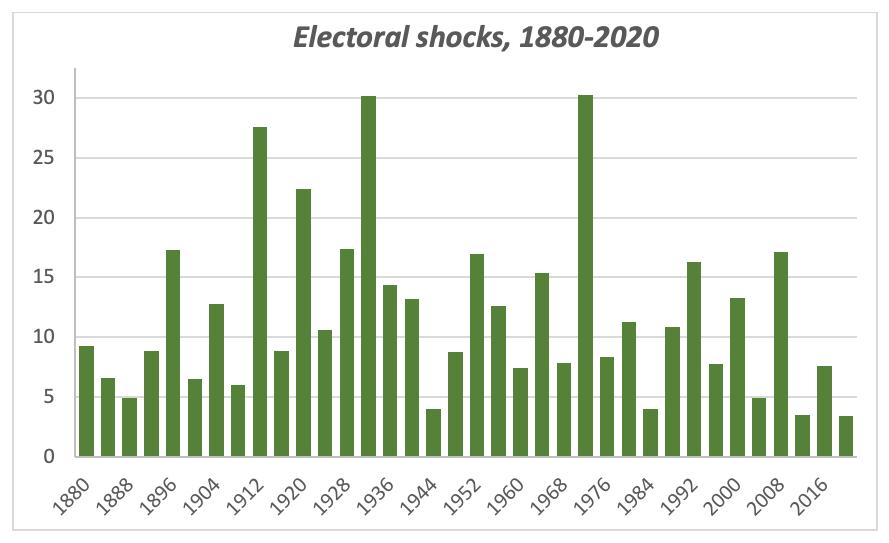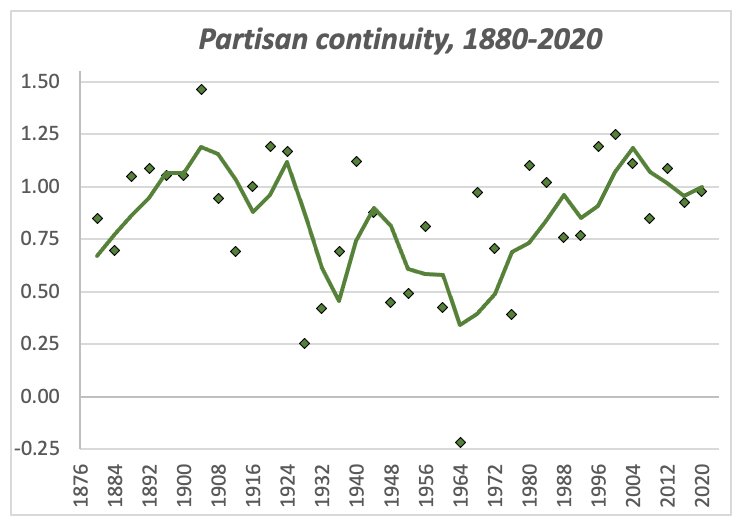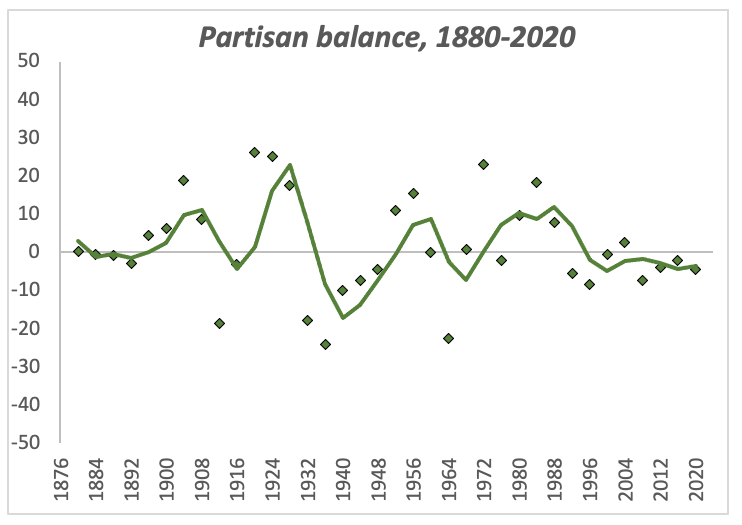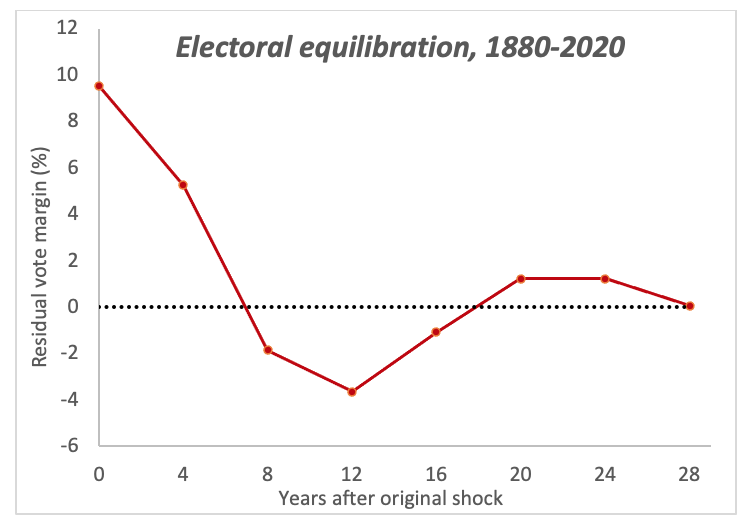SUMMARY
UNIFYING THEME: Polarization: Its Past, Present and Future
By historical standards, America's current electoral environment is remarkably stable, with high levels of partisan continuity and few significant shifts in support from one election to the next. In 2020, neither the tumultuous presidency of Donald Trump nor an influx of more than 20 million new voters made any real dent in this partisan stalemate; state-by-state voting patterns in Trump's narrow defeat almost exactly replicated those in his narrow victory in 2016.
RELATED NEWS:
by Larry M. Bartels, May Werthan Shayne Chair of Public Policy and Social Science
Donald Trump's presidency was one of the most tumultuous in U.S. history. His four years in the White House were a cavalcade of crises, scandals, lies and norm-busting. But through all the drama, public opinion was remarkably unmoved. The president's approval rating remained stubbornly stuck in the forties, and when Election Day finally rolled around, his vote share was virtually unchanged from 2016.
Of course, Trump won in 2016 and lost in 2020-an immensely important difference for the country. But beneath the surface, what is most striking about the 2020 election is how closely the results paralleled those from 2016. Only a handful of states-and no swing states-saw a net shift of more than a few percentage points in Trump's vote share. What makes this stability especially surprising is that 21 million more ballots were cast in 2020 than in 2016-a 16 percent increase in turnout. While more detailed research will be necessary to assess the impact of that massive electoral mobilization, it clearly did not put a significant dent in the country's prevailing partisan alignment. As in the bloody trench warfare of World War I, millions of additional troops and a lot of shelling and muddy hand-to-hand combat shifted the partisan battle lines by mere yards, not miles.

While significant partisan realignments from one election to the next are rare, the electoral stability evident in 2020 is even rarer. Indeed, the correlation between Trump's vote margins in each state in 2016 and 2020 is the strongest for any pair of elections in U.S. history. But it isn't just Trump. The last quarter-century has seen a consistently high level of electoral stability, with correlations between successive presidential vote margins ranging from .93 to .99. America has changed substantially since the late 1990s. Candidates and issues have come and gone. But the partisan trenches remain largely fixed.
Strong correlations between successive state-level vote margins may disguise important shifts if voters all over the country swing uniformly from one party to the other. However, that sort of movement has also been rare in recent years. A measure of "electoral shocks," taking account of both national swings and state-by-state reshuffling, registers few major shifts in recent elections. The only substantial shock of the 21st century came in 2008, when an election conducted in the midst of a cataclysmic financial meltdown saw a significant, mostly uniform decline in support for the incumbent Republican Party. By this measure, the 2020 election registered the smallest electoral shock in at least 140 years-but other recent incumbent reelection efforts, in 2012 and 2004, saw only slightly larger shocks.

Why so much electoral stability in recent years? In broad terms, the explanation is that Americans have become highly polarized along partisan lines-more deeply dug into their respective trenches. Political scientists have traced this polarization to powerful identities and predispositions activated by the momentous social changes of the past several decades.
Systematic historical comparison sheds light on the timing and magnitude of that development. In the three dozen presidential elections since the end of Reconstruction, previous partisan voting patterns have eroded by an average of 15 percent in each cycle. However, the fluidity of the party system was notably greater in the half-century from Al Smith in 1928 to Jimmy Carter in 1976; seven of 13 elections in this period saw previous partisan voting patterns erode by 50 percent or more. In 1964, Democratic support for civil rights precipitated a dramatic realignment of the "Solid South," completely effacing a voting pattern that had persisted for more than eight decades.

The past 40 years have seen much higher levels of partisan continuity in presidential voting patterns-in several cases, hyper-continuity, with previous partisan margins swelling rather than eroding. Even more importantly, the long stretch without a single election seriously disrupting the partisan pattern has produced substantial long-term continuity. For example, the turnout-weighted correlation between Donald Trump's support in each state in 2020 and George W. Bush's in 2000 is .81, exceeding the average correlation (.76) between pairs of successive elections since 1880. The only comparable period of partisan continuity in those 140 years was in the late 19th and early 20th centuries, running from the end of Reconstruction to the fracturing of the Republican Party in 1912.
Paradoxically, both these periods of partisan continuity have also been periods of close partisan competition. While Democrats have won a plurality of popular votes in seven of the last eight elections, none of those victories was by as much as ten percentage points, and the average margin of victory was less than five percentage points. From 1872 to 1900 the partisan balance was even closer, with seven elections decided by an average margin of just 2.6 percentage points.

A prominent scholar of congressional politics, Frances E. Lee, has attributed rising partisan polarization within Congress to Insecure Majorities-the perennially close struggle for partisan control of the House and Senate since 1980. With majority status constantly hanging in the balance, each party has strong incentives to exacerbate partisan conflict-and especially, whenever possible, to make the other party look bad. "Although scholars and commentators normally celebrate the virtues of party competition for purposes of democratic accountability," Lee observed, "it is possible that the U.S. political system works better when the party competitors are less evenly matched."
In presidential elections, insecure majorities are the rule, not the exception. Not all elections are close; but even substantial victories have usually turned out to be transitory. Only once has the same party won three presidential elections in a row by ten percentage points, and that decade of dominance, by the Republicans in the 1920s, was immediately followed by a decade of Democratic dominance in the 1930s. On average, almost half of the winning party's margin in each election has evaporated by the next election, with further equilibration producing an expected reversal of the partisan majority thereafter-pending further electoral developments.

This strong equilibrating tendency probably reflects a variety of forces, including public responses to periodic economic downturns, scandals and (real or imagined) ideological overreach, the exhaustion of winning parties' policy agendas and governing teams and the sheer political inventiveness of losers eager to regain power. Every new administration hopes to overcome these forces, but history suggests that it is more realistic to recognize that political power is fleeting and to accomplish what you can while you have it. That is especially true in the current electoral environment, where vote shifts of a few percentage points one way or the other routinely determine control of the White House and Congress.
Political strategists and (especially) pundits are constantly tempted to misinterpret insecure majorities as harbingers of long-term electoral dominance. Karl Rove, the "political mastermind" behind George W. Bush's election in 2000, hoped to build a durable Republican majority rivaling that of the early 20th century. In 2003, one prominent conservative columnist announced that Rove's realignment "has reached its entrenchment phase. Republicans are tightening their grip on Washington and erasing their weakness among women and Latinos. … Sure, an economic collapse or political shock could reverse these gains. But that's not likely." Likely or not, Bush was barely reelected in 2004, and by 2006 his sagging popularity spurred talk of "The Submerging Republican Majority"-even as books about conservatives' "Drive for Permanent Power" were still making their way into print.
Meanwhile, liberals nurtured their own favorite theory of long-term electoral dominance, envisioning an "Emerging Democratic Majority" fueled by demographic and social change, most notably population growth among Latinos and other non-white groups and the rise of educated urban professionals. So far, however, these developments have stoked a political backlash every bit as powerful, leaving the partisan trenches barely shifted over the past quarter-century.
In politics, as in war, stalemates generally come to unforeseen ends. The end of trench warfare in World War I was hastened by the advent of the tank, a technological development that culminated decades later in a whole new mode of warfare, the Nazi blitzkrieg of World War II. The end of partisan trench warfare in the Gilded Age was hastened by the advent of the Progressive movement, an intellectual development that helped set the stage for a whole new mode of governing, the Democratic New Deal of the 1930s. Where our own long stretch of partisan trench warfare will lead remains to be seen, but for now there is no end in sight.
Further Reading:
- Larry M. Bartels, "Electoral Continuity and Change, 1868-1996," Electoral Studies (1998).
- Marc J. Hetherington and Jonathan D. Weiler, Authoritarianism and Polarization in American Politics (Cambridge University Press, 2009).
- Frances E. Lee, Insecure Majorities: Congress and the Perpetual Campaign (University of Chicago Press, 2016).
- Hans Noel, Political Ideologies and Political Parties in America (Cambridge University Press, 2013).
- James A. Stimson, Tides of Consent: How Public Opinion Shapes American Politics, 2nd ed. (Cambridge University Press, 2015).
[1] According to Dave Leip's Atlas of U.S. Presidential Elections, Trump's share of the national popular vote increased by 0.9 percentage points (from 45.9% in 2016 to 46.8% in 2020), while his share of the two-party vote declined by 1.2 percentage points (from 48.9% to 47.7%).
[2] To minimize the distorting effect of third-party candidacies, my historical analysis of election outcomes focuses on the difference between the Republican and Democratic percentage shares of the total vote in each state in each election. To provide an accurate representation of national political trends, states are weighted by total turnout.
[3] The correlation coefficient is a measure of statistical association ranging from −1 to +1. Either extreme value would reflect a perfect linear relationship, negative or positive, between states' Republican vote margins in two elections; a value of zero would imply that state outcomes in the two elections were (at least, linearly) unrelated.
[4] The measure of "electoral shock" for each election is derived from a turnout-weighted regression analysis relating state vote margins to the corresponding margins in the three previous elections (to allow for possible reemergence of patterns temporarily suppressed by intervening candidates or events). For the logic of this analysis and results through 1996, see Larry M. Bartels, "Electoral Continuity and Change, 1868-1996," Electoral Studies (1998). The measure of "electoral shock" combines the intercept from the regression (representing the national partisan swing) and the standard error of the regression (representing state-specific "local forces"). The numbers shown in the figure represent turnout-weighted average deviations from the partisan margins inherited from previous elections-the square root of the average sum of the squared intercept and the error variance of the regression.
[5] The intercept in the regression of 2020 vote margins on those from 2016, 2012, and 2008 is −2.17 and the standard error of the regression is 2.70, producing a turnout-weighted average (root mean squared) electoral shock of 3.46 points.
[6] See, for example, Marc J. Hetherington and Jonathan D. Weiler, Authoritarianism and Polarization in American Politics; Lilliana Mason, Uncivil Agreement: How Politics Became Our Identity; and Shanto Iyengar, Yphtach Lelkes, Matthew Levendusky, Neil Malhotra, and Sean J Westwood, "The Origins and Consequences of Affective Polarization in the United States," Annual Review of Political Science (2019).
[7] Partisan continuity in each election is measured by the sum of parameter estimates from the turnout-weighted regression analysis relating state vote margins to the corresponding margins in the three previous elections. The average parameter estimates are .656 for the most recent previous election, .200 for the election 8 years earlier, and −.003 for the election 12 years earlier.
[8] While the partisan realignment of the South would continue for decades, the direct imprint of the 1964 election was mitigated by George Wallace's third-party candidacy in 1968. Hubert Humphrey's vote margins in 1968 reflected John F. Kennedy's in 1960 much more than Lyndon Johnson's in 1964 (with regression coefficients of .821 and .183, respectively). On the long-term impact of "critical elections," see Bartels, "Electoral Continuity and Change," 287-291.
[9] The correlation between William Howard Taft's support in 1908 and Benjamin Harrison's in 1888 was .83. The election of 1896 is often portrayed as a partisan watershed, but its imprint on subsequent elections was short-lived. Indeed, regressing the state voting pattern in 1900 on those of previous elections produces coefficients of .473 for 1896, .087 for 1892, and .496 for 1888, suggesting that even a rematch between William McKinley and William Jennings Bryan could not prevent the resurgence of electoral forces predating the emergence of the Populist Party in the 1890s. Thereafter, the pattern of 1896 disappeared entirely, except insofar as it, too, reflected the earlier Gilded Age divisions.
[10] Frances E. Lee, Insecure Majorities, 207.
[11] Regressing the Republican popular vote margin in each election on the margins in the two preceding elections produces parameter estimates of .537 and −.501 (with standard errors of .145 and .144). Statistical analysis suggests that electoral margins have probably evaporated even more quickly in recent decades.
[12] Donald E. Stokes and Gudmund R. Iversen, "On the Existence of Forces Restoring Party Competition," Public Opinion Quarterly (1962); Bartels, "Electoral Continuity and Change," 291-297; James A. Stimson, Tides of Consent (2nd ed.), 68-73.
[13] James Traub, "The Submerging Republican Majority," New York Times Magazine, June 18, 2006, quoting Fred Barnes in The Weekly Standard. Thomas B. Edsall, Building Red America: The New Conservative Coalition and the Drive for Permanent Power (2006).
[14] An early, carefully hedged version of this thesis appeared in a 1997 essay by Paul Starr in The American Prospect on "An Emerging Democratic Majority." A less carefully hedged version appeared in John B. Judis and Ruy Teixeira's 2002 book, The Emerging Democratic Majority.
[15] On the role of intellectuals in the forging of new political ideologies, see Hans Noel, Political Ideologies and Political Parties in America (2013). The most important intellectual blueprint of the Progressive movement was Herbert Croly's The Promise of American Life (1909). In Armament and History (1945), the influential military strategist J. F. C. Fuller used the development of tank warfare to illustrate the shifting balance between defense and offense in the history of war.
[16] Christopher Achen, John Geer, and John Sides provided helpful comments on an earlier version of this report.
